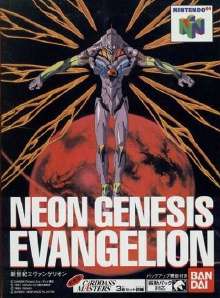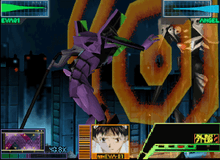Neon Genesis Evangelion (video game)
Neon Genesis Evangelion is a video game released for the Nintendo 64 video game console; it was based on the 1995 - 1996 anime series of the same name and the related full feature animated film The End of Evangelion, which was released subsequently to the anime series in July 1997. The video game was only released in Japan in 1999.
| Neon Genesis Evangelion | |
|---|---|
 | |
| Developer(s) | Bandai |
| Publisher(s) | Bandai |
| Series | Neon Genesis Evangelion |
| Platform(s) | Nintendo 64 |
| Release |
|
| Genre(s) | Action |
| Mode(s) | Single player, Multiplayer |
The game plays through most of the major battles from both the Evangelion series and End of Evangelion film, except for the battles with Gaghiel, Matarael, Iruel, Leliel and Armisael. Half of the levels are side-scrolling, 3D fighting levels, with the player controlling an Eva, while the other half involve their own styles of play.
The game has 13 missions, each focusing on one of the major enemies of the series.
Gameplay

The gameplay is mostly a fighting game between the Evas and Angels. There are three ways the player can play. The most common gameplays is Plain Fighting, where the player takes control of an Eva on a "3D-2D" Course, walking back and forth, attacking the enemy. The battles are mainly focused on pressing correct commands to activate cinematic attacks and grabs known as "Actions", while basics attacks are secondary. Another gameplay style used in the game is weponring. Various parts of the game include minigames as missions, where the player takes control of the Eva's weponring in order to accomplish a mission or objective. The final gameplay element used is free-for-all, where the player is still on a "3D-2D" Plane, but can move freely back and forth. This mode is used in missions 12, 12.5 and 13.
There are also modes outside the missions, such as a training mode named Simulation Mode. In this mode the player selects an Eva that has been unlocked in story mode and practices by shooting un-collared poly-models of different Angels, including ones that are not featured in the Story Mode, and receive a ranking based on how many Angel models are destroyed and how many shots are fired. It is possible to activate a Vs mode by using cheat codes, in which two players can select Evas with different weapons. The other unlockable modes are a sound test and Action Viewer, where the player can review all the Actions executed during the game.
Reception
Four reviewers for Famitsu gave the game a score of 29 out of 40.[1] N64 Magazine gave the game a rating of 61% and highlighted its stylized graphics, but criticized the lack of real gameplay, stating that Neon Genesis Evangelion is "simply a cut-down, 'interactive' version" of the anime series.[4]
Gamers' Republic gave the game a score of B+.[5] Gamers Republic listed the game in the 1999 Video Game Buyers Guide and Y2K Preview as one of the best games to import from Japan that year along with such games as, Bangai-O, The Adventure of Little Ralph, Pepsiman, Robot Dandy, and Internal Section.[6]
References
- "新世紀エヴァンゲリオン [NINTENDO64]". Famitsu. Retrieved 2019-02-25.
- "Frontlines News - Evangelion Goes Polygonal On N64!". Gamers' Republic. Vol. 1 no. 7. Millennium Publishing. December 1999. p. 8.
- Lockhart, Ryan (January 1999). "Tokyo Game Show - Evangelion - Beat Down Shinji". Gamers' Republic. Vol. 1 no. 8. Millennium Publishing. p. 105.
- Bickham, Jes (November 1999). "Neon Genesis Evangelion". N64 Magazine. No. 34. Future Publishing. p. 68.
- "World Republic Review: Evangelion". Gamers' Republic. Vol. 2 no. 4. Millennium Publishing. September 1999. p. 89.
- "Best of Imports '99". Millennium Presents: 1999 Video Game Buyers Guide and Y2K Preview. Millennium Publications. 1999. p. 116.